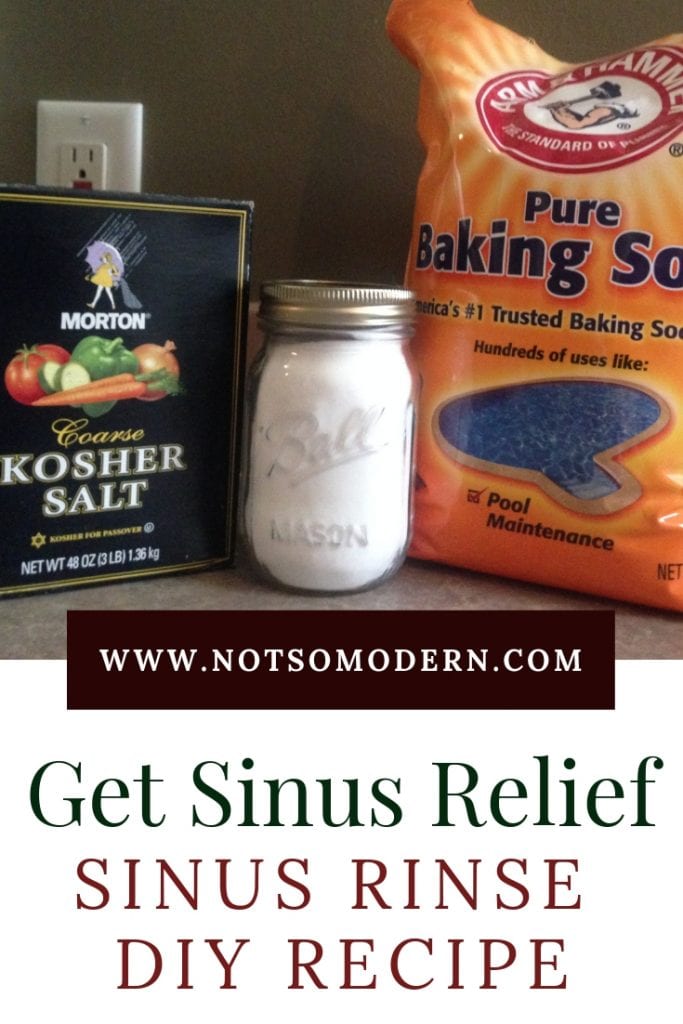Cold and flu season is in full effect, and everyone is experiencing the same symptoms: sore throat, sinus congestion, runny nose, headache, sneezing and coughing. What many people fail to realize is that all of these symptoms come from the same source: sinus irritation, swelling and drainage. There is one way to receive relief from these symptoms: a saline rinse.
I first learned about sinus rinses 10 years ago when sinus congestion was causing daily headaches.
Looking for relief, I visited an Ear, Nose, and Throat (ENT) doctor, who recommended saline sinus rinses twice a day.
Pin this article for later:

What is a Saline Sinus Rinse?
A saline sinus rinse is a form of nasal irrigation that uses a saline solution and a squeeze bottle to flush out the nose and sinus cavity. The rinse flushes out mucus and infection from, removes nasal irritants from, and inhibits bacteria growth in nasal passages.
It also restores moisture and reduces inflammation of the mucus membranes, which relieves many of the symptoms of sinus pain, even when drainage is not present.
How is a Saline Sinus Rinse Performed?
A sinus rinse is performed by mixing saline powder with distilled water in a bottle designed to squirt saline up one nostril of the nose.
The solution goes up one side of the nose, into the sinus cavity, and drains out the opposite open nostril.
Because the liquid and mucus flush out of the opposite nostril at will, it is best performed while you tilt your head over a sink or while you are in the shower.
Where Can You Purchase Sinus Rinse Kits?
The two most common brands of sinus rinse kits on the market are made by NeilMed and Ayr. Another popular option is the Neti Pot by NeilMed. These kits can be purchases in most pharmacies. They come with a bottle and several packets of powder to mix your own saline solution with distilled water.
You could also mix your nasal saline in a cup or bowl and use a bulb syringe to flush our your nasal passages. You will find that you need to tip your head a little more than usual to get the fluid to travel out of the other nostril, but it works just as well.
If you start with a store bought kit, you can purchase additional packets of dry saline mix when you use up your starter kit. The problem is those packets can get expensive, and they create a lot of waste from the additional packaging.
When I was performing sinus rinses twice a day, everyday, I found that I was going through those little powder packets in record time. I needed to find a better solution.
As it turns out, the saline powder can easily be made at home with iodine-free salt and baking soda. It’s a simple mixture that can be stored in a mason jar.
Do you have to use distilled water?
There is a lot of confusion as to why tap water cannot be used when performing a sinus flush.
In fact, you can use tap water, but it needs to be boiled before use to kill any microscopic organisms living in your water supply.
Ever watched an episode of House? You don’t want some weird parasite multiplying in your brain.
But you also don’t want to squirt boiling water up your nose. It has to cool completely before you use it. That means you need to plan ahead if you are going to use tap water for your sinus rinse.
The more convenient option is a bottle of distilled water kept at room temperature (you don’t want to squirt cold water up your nose either).
Distilled water has had all of its impurities removed, so it’s safe to use for a saline rinse.
Ready to make some of your own saline powder?
Sinus Rinse Saline Powder
This saline powder is easy to make and great to have on hand for performing a sinus rinse with a Neti Pot or squeeze bottle.
Materials
Dry Ingredients
- 1 c. Iodine-Free Salt
- 1 c. Baking Soda
Sinus Rinse Solution
- 1/4 tsp Dry Mix
- 8 oz Distilled Water
Tools
- Food Processor
- Sinus Flush Bottle
- Air-tight Container
Instructions
- In a food processor, mix dry ingredients together for about 1 minute to blend well.
- Store in an airtight container.
- When you're ready to make a saline solution, mix 1/4 tsp of mix with 8 oz of distilled water. If you do not have distilled water, you can boil water for 5 minutes and cool it before use. Make sure it is completely cooled to prevent burning the inside of your nose. I find that it's just easier to keep a bottle of distilled water handy.
- Lean over the sink while you perform your sinus rinse.
- When you flush your nostrils, the saline solution will go up one nostril and come out the other. Some of the solution may also come out of your mouth, so I recommend keeping your mouth open.
- Place the tip of the bottle up one nostril and squeeze the liquid into your sinuses.
- Do not try to force too much liquid at once to prevent hurting your eardrums.
- It will be a strange sensation the first time, but it should not burn. If it does, then your salt/baking soda/water ratio is off.
- Flush 8 oz of solution up each nostril.
- When you're finished, there will still be some solution in your sinuses. It will drain with time, but you may find it draining at very inconvenient times (like when you're bent over a basket of clean laundry).
- If you want to blow out some of the saline, do so very gently and do not block one nostril to blow out the other. You will almost certainly damage an ear drum and cause yourself a lot of pain.
Recommended Products
As an Amazon Associate and member of other affiliate programs, I earn from qualifying purchases.
When you finish your sinus rinse, you will notice that there is still some fluid in your sinus cavity.
DO NOT BLOW YOUR NOSE
You will pop your ear drums. Just don’t do it.
Lean forward and allow the extra to drain out naturally. Use a tissue catch the drips. Very gently blow air through both nostils at the same time. Just do not block one nostril and blow hard. You’ll regret it.
Sanitize Your Bottles
Make sure you sanitize your bottle or syringe after each use to prevent bacteria growth. You can do so by running it in the dishwasher or placing it in boiling water for a few seconds.
Medela Quick Clean Micro-Steam Bags are an easy way to sanitize bottles in the microwave. The bags are designed for baby products, but they’ll work for anything that will fit in the bag.
I’ve had a couple of surgeries in the years since I started using my sinus rinse recipe, but it’s still useful to relieve sinus pressure, clear sinus infections, and treat seasonal allergies. I always keep some on hand in my bathroom for those times when I need relief.
Looking to connect with like minded people who are interested in gardening, traditional living, and being more self sufficient? Join our community on Facebook – Not so Modern Living.
Need an extra little kick to help your sinuses drain? Check out this DIY Decongestant Recipe from Healing Harvest Homestead.

